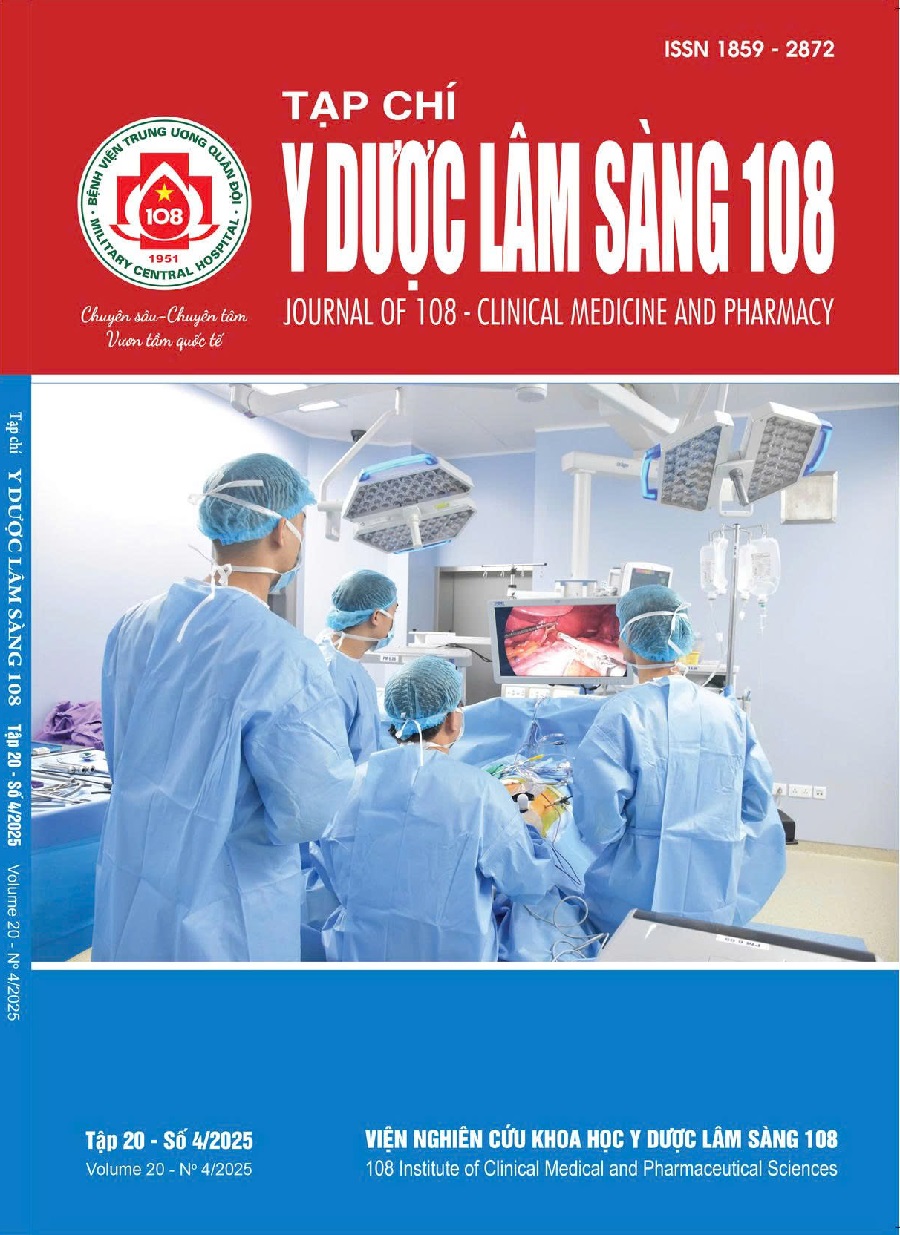Evaluating the prognostic value of urinary liver-type fatty acid-binding protein (L-FABP) in predicting mortality among patients with sepsis and septic shock
Main Article Content
Keywords
Abstract
Objective: To evaluate the prognostic value of urinary liver-type fatty acid-binding protein (L-FABP) in predicting mortality among patients with sepsis and septic shock. Subject and method: A prospective descriptive study was conducted on 212 patients with sepsis and septic shock at Military Central Hospital 108 from January 2021 to August 2024. Urine specimens were collected at the time of hospital admission, and urinary L-FABP levels were semi-quantitatively measured. In multivariate analysis was performed to determine whether L-FABP is an independent predictor of 7-day mortality and in- hospitality mortality. Result: The urinary L-FABP concentration in the 7-day mortality group was 31.71 (11.39-176.87) µg/g-Cre, which was significantly higher than in the survivor group [18.14 (5.09-35.45) µg/g-Cre]. Similarly, the concentration in the in-hospital mortality group 42.86 (17.71-73.63 µg/g-Cre was higher than that in the survival group [12.11 (3.70-21.00) µg/g-Cre]. At a cutoff point of urinary L-FABP = 19.34 µg/g Cre, the biomarker demonstrated a sensitivity of 70.2% and a specificity of 71.1% in predicting in-hospital mortality, with an area under the curve (AUC) of 0.80. Conclusion: The urinary L-FABP concentration is a valuable biomarker in predicting 7-day mortality and in-hospital mortality in patients with sepsis and septic shock.
Article Details
References
2. Kalakeche R, Hato T, Rhodes G et al (2011) Endotoxin uptake by S1 proximal tubular segment causes oxidative stress in the downstream S2 segment. J Am Soc Nephrol 22(8):1505-16. doi:10.1681/asn.2011020203
3. Asakage A, Ishihara S, Boutin L et al (2024) Predictive Performance of Neutrophil Gelatinase Associated Lipocalin, Liver Type Fatty Acid Binding Protein, and Cystatin C for Acute Kidney Injury and Mortality in Severely Ill Patients. Ann Lab Med 44(2): 144-154. doi:10.3343/alm.2023.0083
4. Doi K, Noiri E, Sugaya T (2010) Urinary L-type fatty acid-binding protein as a new renal biomarker in critical care. Current opinion in critical care 16(6): 545-549. doi:10.1097/MCC.0b013e32833e2fa4
5. Doi K, Noiri E, Maeda-Mamiya R et al (2010) Urinary L-type fatty acid-binding protein as a new biomarker of sepsis complicated with acute kidney injury. Crit Care Med 38(10): 2037-2042. doi:10.1097/CCM.0b013e3181eedac0
6. Singer M, Deutschman CS, Seymour CW et al (2016) The Third International Consensus Definitions for Sepsis and Septic Shock (Sepsis-3). Jama 315(8):801-10. doi:10.1001/jama.2016.0287
7. Rhodes A, Evans E, Alhazzan W et al (2017) Surviving sepsis campaign: International guidelines for management of sepsis and septic shock: Crit Care Med 45: 486-552.
8. Suzuki G, Ichibayashi R, Yamamoto S, Nakamichi Y, Watanabe M, Honda M (2019) Clinical significance of urinary L-FABP in the emergency department. International journal of emergency medicine 12(1): 24. doi:10.1186/s12245-019-0244-9
9. Parr SK, Clark AJ, Bian A et al (2015) Urinary L-FABP predicts poor outcomes in critically ill patients with early acute kidney injury. Kidney Int. Mar 2015;87(3):640-8. doi:10.1038/ki.2014.301
10. Xie Y, Li B, Lin Y, et al. Combining Blood-Based Biomarkers to Predict Mortality of Sepsis at Arrival at the Emergency Department. Med Sci Monit. Feb 25 2021;27:e929527. doi:10.12659/msm.929527
11. Seo MH, Choa M, You JS et al (2016) Hypoalbuminemia, Low Base Excess Values, and Tachypnea Predict 28-Day Mortality in Severe Sepsis and Septic Shock Patients in the Emergency Department. Yonsei Med J 57(6): 1361-1369. doi:10.3349/ymj.2016.57.6.1361
12. Thuijls G, van Wijck K, Grootjans J et al (2011) Early diagnosis of intestinal ischemia using urinary and plasma fatty acid binding proteins. Ann Surg. Feb 253(2): 303-308. doi:10.1097/ SLA.0b013e318207a767
13. Voth M, Holzberger S, Auner B, Henrich D, Marzi I, Relja B (2015) I-FABP and L-FABP are early markers for abdominal injury with limited prognostic value for secondary organ failures in the post-traumatic course. Clin Chem Lab Med 53(5): 771-780. doi:10.1515/cclm-2014-0354
 ISSN: 1859 - 2872
ISSN: 1859 - 2872
